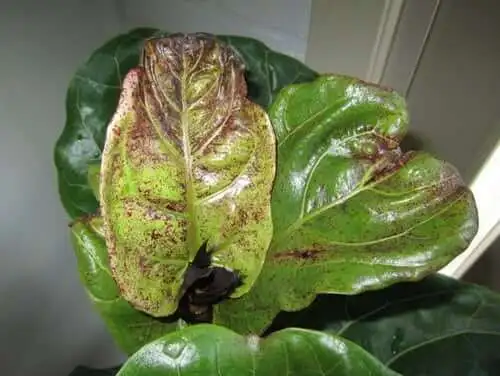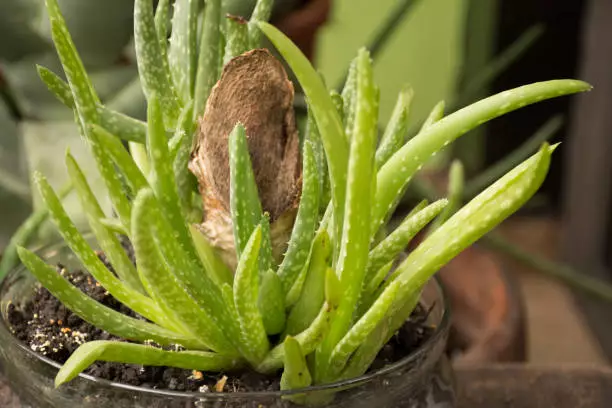Sunflower microgreens are a healthy addition to one’s diet. Young sunflower plants are naturally high in nutrients and extremely easy to grow. You can grow sunflower microgreens on your balcony, on your counter, or for commercial use.
What are sunflower microgreens?
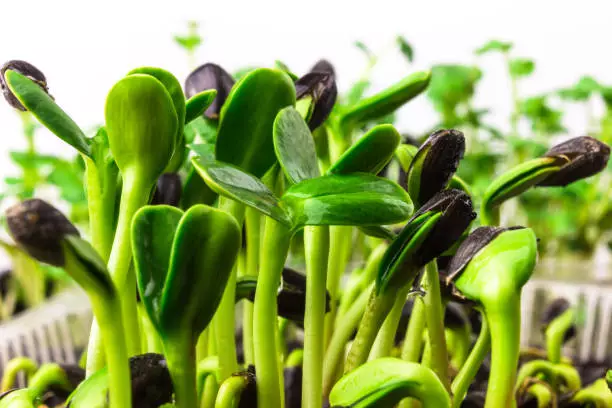
Sunflower microgreens are edible, green vegetables harvested at a young age (just after their cotyledons develop). Although microgreens share several similarities with sprouts, it’s still surprising that people might mistake sunflower microgreens for sprouts despite their apparent differences.
Both sets of plants pack a high amount of nutrients and are a highly recommended food source for healthy living. Sunflower microgreens are relatively easy to grow, maintain and occupy little time before they are ready for harvesting. Besides, these foods will give you a natural source of vitamins and minerals that can easily outmatch any vitamin supplement.
How to grow sunflower microgreens
Growing sunflower microgreens is relatively easy, inexpensive, and quick. The plants don’t occupy a lot of space and can be ideal for personal and commercial use. You need to consider the type of seeds you intend to use.
Black sunflower microgreens are a popular choice for most enthusiasts. The seeds are readily available online, in seed banks, botanical clinics, etc. Also, ensure that you purchase your seeds from recognized vendors to assure quality, price, and other added information or advice.
Here are a few tips on how to properly grow sunflower microgreens:
1. Prepare a nutritious growing medium
Sunflower microgreens require a nutrient-dense potting medium to facilitate growth. These small plants grow best under potting soil or coco coir (a fiber made using coconut husks). You can also opt to grow the plants using hydroponics, although it might be slightly more expensive than the other means.
2. Soak the seeds for 12 hours
You have to soak your sunflower seeds before planting. Some experts recommend first weighing the seeds before proceeding to immerse them in water for about 12-24 hours, depending on the temperature, and warmer temperatures can reduce the amount of time needed for soaking to a period of about 12 hours.
Sunflower seeds are relatively light, and you might have some issues getting them to sink under the soaking water. It’s essential to use fresh water (with a neutral pH) during soaking. Sunflower seeds are susceptible to pH changes and might affect the quality of your plants.
You can always try putting weights, such as a smaller glass filled with water, and have the glass submerged upside down in an enormous container to ensure all seeds remain under the surface.
Soaking the seeds in water initiates the germination process and activates dormant enzymes present in the seed.
3. Clean the growing tray using hydrogen peroxide solution
There are several options available when looking for an ideal growing tray for your seeds. You can try purchasing one from recommended vendors or recycling an old container. Washing your tray is essential because it hinders the development of pathogens that could affect the health of your plants. Ideally, it’s best to use soapy water with a hydrogen peroxide disinfectant.
Official gardening trays have drainage holes that allow excess water to run off with ease. If you decide to re-use an old container, also ensure that you drill enough drainage holes on the bottom.
4. Sow the seeds shallowly
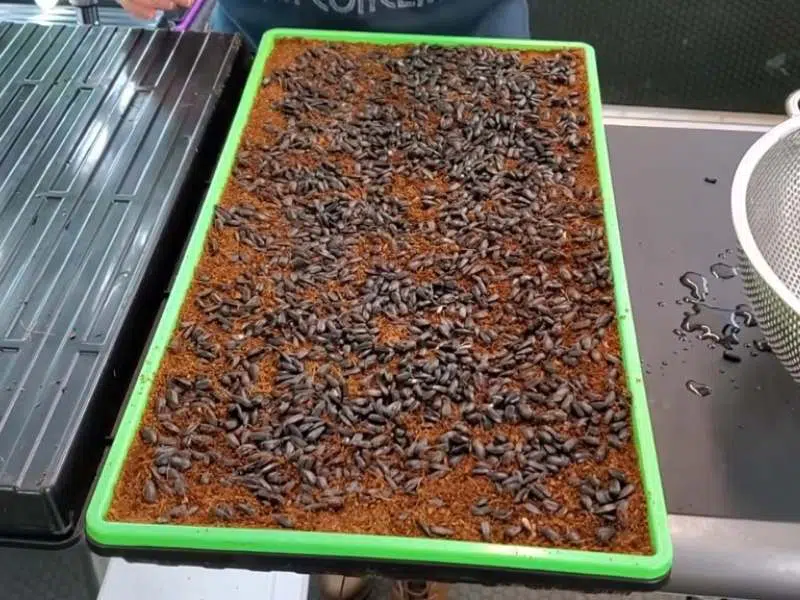
Sowing your microgreens is a sensitive process that demands plenty of care and attention. Calculate the number of seeds you require per tray before seeding, and evenly distribute the seeds within the confines of the container. Microgreens only need a thin layer of soil to grow, so don’t plant them too deeply or not grow properly.
5. Cover the seeds with a dark piece of cloth
Microgreens germinate best when placed in dark, warm, and humid conditions. After seeding, always ensure that you cover up your growing tray with a lid or dark paper and place the tray in a dark space, such as a closet.
6. Water the sunflower microgreens lightly
Water your microgreens periodically (preferably once every 12 hours) using a water spray before returning the tray to its dark confines.
7. Move the germinating seeds to a well-lit area
After a few days, you might notice your seeds begin to shoot from the soil. Transfer the seeds to a well-lit area and continues watering the young plants until they grow their first set of leaves.
How to take care of your sunflower microgreens
Microgreens require special care and attention during their early stages of growth. The small plants have tender stems and fragile leaves that can be easily damaged by mishandling. It’s essential to consider a few trivialities when dealing with such plants.
Some of the aspects to consider include:
Mist your microgreens every day
Watering your seeds is an integral part of the day. However, adding water directly from a watering container can cause damage to the delicate plants. Instead, you can try using a water spray bottle to mist the soil surface until it is moist.
Ideal temperature/humidity
Microgreens grow best under warm temperatures with an ideal range of between (68-77℉) and 50 to 60% room humidity. Growing your seeds in cooler regions might require a room warmer to adjust the temperature deficit.
Removing hulls
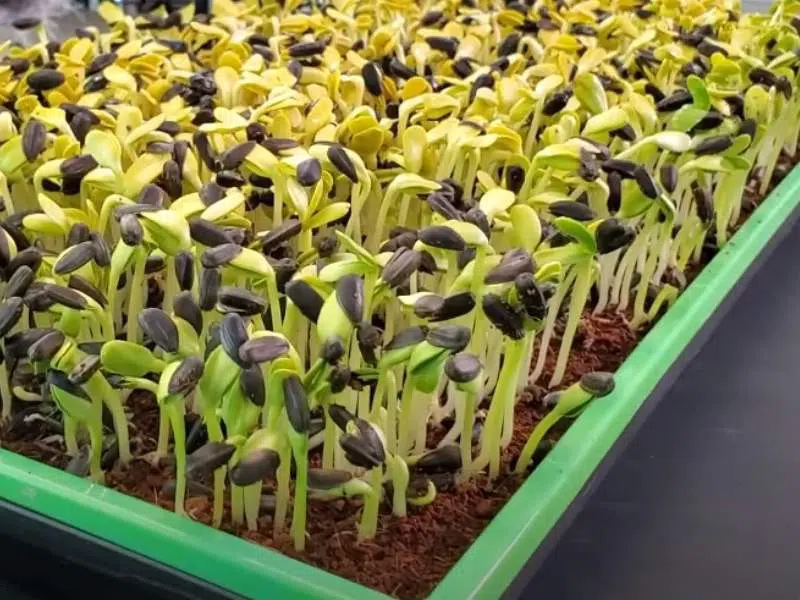
Rub the sunflower microgreens with your hand to encourage them to shed their outer layers while taking care not to cause damage to the leaves and stems.
Hulls are a pesky problem when growing microgreens. They form as the plant gets rid of its outer shell and develops into maturity. Although hulls eventually fall off as the plant grows, some might remain and become a bother during harvesting.
Harvesting your microgreens
Your microgreens should be ready for harvesting within a few days to two-three weeks, depending on the prevailing growing conditions. More details on harvesting are below.
Sunflower microgreens seeds
There are several varieties of sunflower seeds. A common choice for people is the Black sunflower seeds, which are primarily inexpensive and relatively easy to grow.
A few sunflower seed varieties include:
Terrasoul Superfoods Organic Hulled Sunflower Seeds– Terrasoul are organic sunflower seeds available to the US market. The products retail on various online marketplaces, including Amazon.
Antony’s Organic Hulled Sunflower seeds– Antony’s hulled sunflower seeds are USDA-approved products with gluten-free properties. They are edible products that can be consumed as a snack or added to a variety of dishes.
GERBS roasted whole sunflower seeds– GERBS raw sunflower seeds are ideal for individuals looking for a healthy lifestyle. The products feature no artificial additives and provide a natural and healthy alternative to consumers.
Harvesting tips
Sunflower microgreens are easy to harvest, as the plants require only cotyledon development and a few true leaves to be ready. You might need to use a sharp knife or scissors to make proper cuts on the stems. Always wash your microgreens after harvesting to remove dirt and any pathogen infestations. It’s also advisable to consume the products while they are fresh.
Microgreens tend to wither and lose quality quickly if left unconsumed for long. Refrigeration may be an option for extending the product’s lifespan, but it might also cause an unwanted change in taste.
Here are a few steps on how to properly harvest sunflower microgreens:
- Identify mature microgreens- The seed batch maturing at a different time makes it crucial to identify your mature microgreens. Delaying harvesting may cause bitter leaves (while too early harvesting may reduce your yield).
- Make a precise cut along the stem just above the soil line – Microgreen stems are short and tender, so it should not be too challenging.
- Wash, pack, and store your harvest under ideal conditions.
How do sunflower microgreens taste
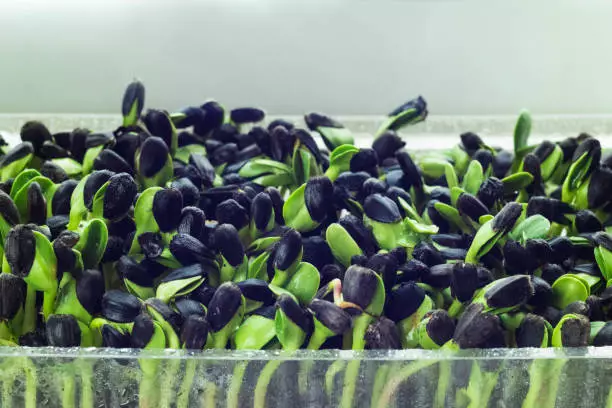
Sunflower microgreens have a fresh, green, nutty taste. Some varieties have a lemony aftertaste, while others have a taste similar to the mature plant. Overgrown microgreens have a more rigid leaf texture than the younger versions of the same plant, which tend to be soft and easy to chew.
You can consume the microgreens raw or by adding them to several dishes and stews.
Sunflower sprouts vs. microgreens
Although people often mistake one for the other, sprouts are very different from microgreens. A sprout is a germinated seed formed once the shoot breaks the soil surface, and photosynthesis has not yet occurred. In contrast, a microgreen is a much larger plant with experienced photosynthesis and has started developing leaves.
You can quickly grow both from seeds. Sprouts grow best under dark conditions, but microgreens need light to mature. Most sprouts have a bland, salad-like taste and pack fewer nutrients compared to the latter. The reasoning is that water absorbed in germination contributes to the taste, and photosynthesis increases the quantities of essential nutrients available to the plant.
Benefits and nutrition
Sunflower microgreens have lots of health benefits. Nutritionists agree that regular consumption of sunflower microgreens can help individuals deal with several lifestyle conditions, including diabetes, cancer, vitamin deficiencies, and a boost to the immune system. Microgreens are also rich in antioxidants, which help reduce inflammation and a myriad of other health conditions.
Here are some of the essential nutrients adequately found in microgreens (source).
| Nutrients | Percentage (% per 100g) |
| Fiber | 2.2 |
| Protein | 2.2 |
| Calories | 28 |
| Vitamin C | 0.66 |
| Vitamin A | 7.96 |
| Folate | 6.6 |
| Calcium | 8.8 |
| Iron | 15.9 |
| Potassium | 2.98 |
| Carbohydrates | 4.4 |
| Phosphorous | 6.6 |
| Magnesium | 6.6 |
